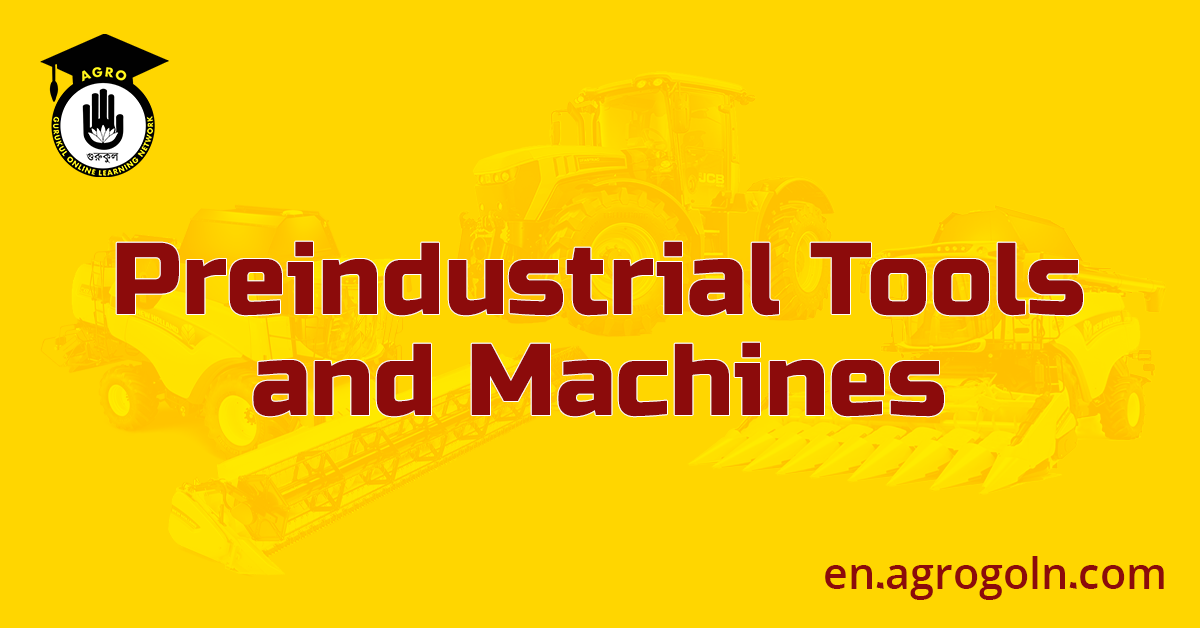The story of human progress is inextricably linked with the development of agricultural tools and machines. Before the rise of industrial agriculture in the late 18th century, centuries of innovation and craftsmanship had seen the birth of an array of preindustrial tools and machines, which laid the groundwork for modern agricultural practices.
Table of Contents
Preindustrial Tools and Machines

These tools, from simple handheld devices to complex machinery, played a vital role in shaping societies, economies, and landscapes. This article will delve into the history of these preindustrial tools and machines and explore their significance in the evolution of agriculture.
The Dawn of Agricultural Tools
Agriculture dates back approximately 10,000 years to the Neolithic Revolution when our hunter-gatherer ancestors began to settle and cultivate crops. The earliest agricultural tools were rudimentary and made from readily available materials such as stone, wood, and bone. A digging stick or a simple hoe was likely the first tool used to break the soil for planting.
As societies developed, so did their tools. The use of metals like copper, bronze, and eventually iron led to stronger, more durable tools. The Bronze Age saw the development of plows, sickles, and axes, enhancing efficiency in farming and forestry.
The Iron Age and Beyond: Advancements in Tool Making
The Iron Age heralded significant advancements in tool making. Iron tools were stronger and sharper than their bronze counterparts, enabling more efficient farming practices. The ard, or scratch plow, was an Iron Age innovation that could break up the soil without turning it over, making it possible to cultivate heavier soils and increase crop yields.
Around the first millennium BCE, the heavy moldboard plow was invented. Unlike the ard, this plow could turn the soil over, effectively burying weeds and crop residues and improving soil fertility. This tool, often pulled by oxen or horses, was a game changer in agriculture, especially in the heavy, fertile soils of Europe.

Water and Wind Power: The First “Machines”
The harnessing of natural forces marked the introduction of the first “machines” in agriculture. Around 6000 BCE, ancient Egyptians began using simple machines to move water from the Nile River to their fields. This was likely the earliest form of irrigation, a practice that significantly enhanced crop yields.
By 200 BCE, the Greeks had invented the waterwheel, a machine that used the power of flowing or falling water to drive other machinery. Waterwheels were primarily used for milling grain—an energy-intensive task that had traditionally been done by hand.
The windmill, another significant invention, was first used in Persia around 500-900 CE. Like waterwheels, windmills harnessed natural forces (in this case, wind) to perform tasks such as milling grain and pumping water.
Animal Power: Harnessing the Strength of Beasts
The domestication of animals had a profound impact on preindustrial agriculture. Oxen and horses were used to pull plows and carts, reducing the human labor required for these tasks. Over time, various types of harnesses and yokes were developed to improve the efficiency of animal power.
Around 1000 CE, the invention of the horse collar revolutionized farming. This device allowed horses to pull heavy loads without choking, making them more efficient than oxen for many tasks. With their faster speed and greater endurance, horses became the power source of choice for many farmers.
The Eve of Industrialization
By the 18th century, many of the tools and techniques that would feed into the Industrial Revolution were already in place. Improved plow designs, advancements in animal husbandry, and a better understanding of crop rotation had led to increased agricultural productivity.
At the same time, a series of inventions set the stage for the mechanization of agriculture. The seed drill, invented by Jethro Tull in the early 18th century, allowed seeds to be sown in uniform rows at specific depths. This improved germination rates and crop yields, marking a significant step forward in farming efficiency.

The preindustrial era was a time of significant innovation in agricultural tools and machines. From the simple digging stick of our Neolithic ancestors to the complex waterwheels and windmills of later centuries, these tools and machines transformed agriculture and, by extension, human societies.
The dawn of the Industrial Revolution in the late 18th century marked a significant shift in agriculture. The advent of steam power and later, internal combustion engines, would revolutionize agricultural machinery and dramatically increase farming efficiency. However, these advancements were built upon the foundations laid by thousands of years of preindustrial innovation. The tools and machines of this era remain testament to human ingenuity and our enduring quest to shape the environment to our needs.
#Agro #Agriculture #AgroGurukul #AgricultureGurukul #GurukulOnlineLearningNetwork
